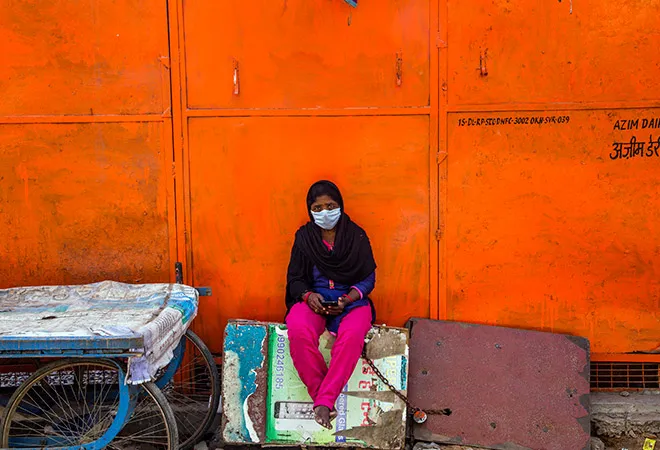
The Indian lockdown, referred to as one of the world’s most stringent, did less for social distancing and flattening the Covid-19 curve than the desperation and helplessness it brought upon the migrants of the nation. The lockdown rendered the migrants unemployed, with hardly any buffer resources to last the days of the lockdown. They became victims of starvation and homelessness. So adverse were their circumstances that they were forced to walk their way to their hometowns located several hundred kilometres away. Despite the fact that the migrant workers form the sinew and steel of the urban economy, the neglect towards their welfare has been aptly demonstrated by the pandemic.
Uttar Pradesh and Bihar constitute a major chunk of the total out-migration in the country. As such, one would expect reverse migration to be maximum to these states. According to certain official data on reverse migration, about 2.169 million have returned to Uttar Pradesh (UP), while one million have returned to Bihar. The big question that confronts the UP and Bihar governments is how to rehabilitate these migrants in terms of food, other forms of support and livelihoods.
The states of Bihar and UP represent the middle Gangetic plains of India. This region is characterised by a large population with UP (237.9 million) being the most populous state in India followed by Bihar (125 million).The level of economic and human development in these states has hardly been able to accommodate the essential needs and aspirations of their rising populations. Of this vast population, only 11.3 percent and 22.28 percent resides in urban areas in Bihar and UP respectively. According to the Periodic Labour Force Survey for 2017-18, the unemployment rate in Bihar and UP stands at 7.2 percent and 6.4 percent respectively, both greater than the national average of 6.1 percent. These figures imply that the huge population pressure and the lack of urbanisation is responsible for lack of employment opportunities compelling out-migration from these states. Landlessness, seasonal nature of farming, underemployment, low wages etc are significant drivers of out-migration.
The positive
Has migration really helped individuals become economically empowered citizens of the nation? One of the indicators of such economic empowerment is the ability to withstand economic shocks. The Covid-19 pandemic has been one such shock. It has pushed the migrants into the gulf of poverty because they did not have enough buffer resources to last the lockdown, no social protection measures to support them in the worst of economic times. Relief measures for migrants were very poorly targeted.
There are three principles that the rehabilitation strategy must embody: Support, protection and empowerment. In the short run and the medium term, migrants need to be supported and protected. In the long run, they need to be empowered. In the short run, they need to be provided by food supplies and cash support. Under the Atma Nirbhar Abhiyan package, the government has announced for migrants who are neither beneficiaries under the National Food Security Act nor under the state ration card a provision of 5 kgs of grains and 1 kg of pulses per month up to the end of August 2020. Many experts believe that given the surpluses in government stocks, the provision of supplementary ration can easily be increased several times. The government has also announced the launch of the ‘One Nation One Ration Card’ system which will allow migrants to access PDS from any Fair Price Shop in the country.
It is also imperative to provide cash transfers per month for at least three months of INR 6,000 which is equivalent to the MNREGA wage of INR 200 per day as argued by the Indian Society of Labour Economics. The implementation of these schemes seems questionable given the obsession of the government to identify circular migrants who do not possess the necessary eligibility documents. These immediate interventions should not be subject to domicile-based access.
For the period slightly beyond the short run, the question of unemployment needs to be answered. This is indeed a concern given unemployment and underemployment in both the states. Under the Atmanirbhar Bharat Abhiyan, the scope of MNREGA has been expanded by earmarking INR 40,000 crores to accommodate the returning migrants. Furthermore, the government has launched the Garib Kalyan Rojgar Yojana by combining 25 ongoing rural employment programmes for an expenditure of INR 50,000 crore to generate 125 days of work for returning migrants. The implementation of the Garib Kalyan Rojgar Yojana must create new job opportunities and not displace existing workers given that it is a consolidation of existing schemes. Generation of new employment opportunities is necessary to prevent depression of rural wages.
Will those who returned from the cities consider migrating again? Migrants have faced such neglect and humiliation as to have developed trust deficits, lack of trust on their employers and on the governments, both of whom largely failed to come to their rescue in their hardships. As far as the employers are concerned, it is the informal nature of work that is to be blamed. Formal employment typically entails support necessitated by adversities. PM Modi has called for a self-reliant India. Can informality driving the fate of as many as 93 percent of the workforce allow Atmanirbharta or self-reliance? The government has to seek ways to make formal employment the reality of India. If there was adequate social protection for migrants, their mass exodus could very well have been averted. The government must think about the social security needs of the migrants. There is a need to articulate a campaign for the right to basic needs of migrants irrespective of documentation.
To devise appropriate welfare schemes and development strategies for the circular migrants, it is very important to have reliable and nationally representative statistics. Unfortunately, the authorities concerned are not in possession of such numbers. In the medium term, it is required of authorities to map the migration profile of the nation and create knowledge and better comprehend the realities and issues of the migrants.
To devise appropriate welfare schemes and development strategies for the circular migrants, it is very important to have reliable and nationally representative statistics. Unfortunately, the authorities concerned are not in possession of such numbers
Finally, in the long run, both UP and Bihar need to revive industrialisation and the chosen strategy to do so can be rural development leading to in-situ urbanisation. Poor governance is one of the hurdles that is preventing private investments from increasing in both the states. Both states are characterised by low ease of doing business. Steps need to be taken to improve the same. Given the current reality of migrants, their social mobility becomes a question. Industrialisation and ensuing urbanisation must address this. The Atmanirbhar Bharat Abhiyan does refer to fast-tracking investments and boosting investment in the country, manufacturing, upgrading and augmenting industrial infrastructure. The focus of this campaign must but logically be on the two most populous but underdeveloped states of the nation.
The views expressed above belong to the author(s). ORF research and analyses now available on Telegram! Click here to access our curated content — blogs, longforms and interviews.




 PREV
PREV


